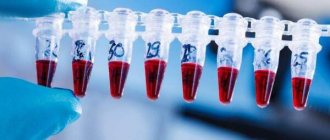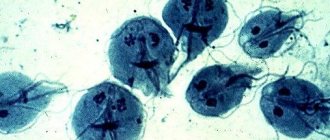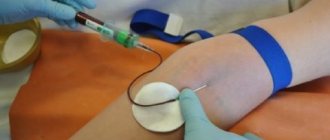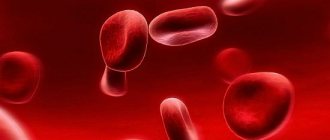To accurately detect the presence of HCV, determine its activity and the nature of damage to the body, it is necessary to perform a blood test for hepatitis C, consisting of several tests of immune serum (antiserum). It will identify markers of infection - antibodies produced by the body upon contact with a foreign body, as well as indicators indicating HCV infection.
Depending on the individual characteristics of the carrier and the genotype of the virus, antibodies can remain in the body for a long time and even for life. A negative anti-HCV test indicates that the immune system has never been exposed to HCV or has been exposed to HCV within six months of the test.
A positive response to anti-HCV indicates that the human body has been in contact with an RNA virus. When antibodies are detected, the doctor can accurately say that the patient either suffered an acute form of the disease in the past, or the virus is still present in the body, and the disease has become chronic.
Main sources of infection
The main source of hepatitis C infection is a sick person. Sometimes someone who is a carrier of the virus does not show clinical symptoms of hepatitis c. The route of infection with hepatovirus is through the blood. This can happen any time the blood of an infected person comes into contact with the blood of a healthy person. The most common ways to become infected are:
- children from mother during childbirth;
- medical workers during manipulations;
- in adults, hepatitis most often enters the bloodstream due to visiting nail salons, tattoo and piercing salons, where they can work with instruments without proper disinfection;
- the disease is often found in drug addicts who inject drugs into their veins;
- sexual intercourse, although rare, can also provoke infection with hepatovirus.
Read more about the main source of Hepatitis C infection here.
What to do if you are diagnosed with hepatitis C?
We check blood for viruses and infections
There are three types of tests to evaluate patients: liver enzymes, antibodies to hepatitis microorganisms, and foreign proteins or genetic material (DNA or RNA).
Liver enzymes. Among the most sensitive and widely used diagnostic blood tests are those that measure aminotransferase levels.
These include aspartate aminotransferase and alanine aminotransferase. These enzymes are usually found in liver cells. If it is damaged (as with viral hepatitis), these substances enter the blood, signaling that the liver is damaged. If a person does not have liver disease, then a blood test will not reveal any changes.
The normal range of AST values is from 5 to 40 units per liter of serum (the liquid part of the blood). Typical ALT levels range from 7 to 56.
Levels may vary slightly depending on the laboratory in which they are performed. Patients with acute viral hepatitis may have very high concentrations of enzymes, sometimes up to several thousand. They become normal after a few weeks or months as patients recover completely.
In patients with chronic infection, levels of substances are slightly elevated, but such levels are observed for years or decades. To prove that it was the hepatitis virus that caused the inflammation of the gland, the blood must be tested for the presence of antibodies to each type of pathology.
Antibodies are proteins produced by white blood cells that attack invaders such as bacteria and viruses. They are usually found in the blood within a few weeks of infection, and remain for decades after the illness ends.
The analysis can be useful in diagnosing both acute and chronic hepatitis.
In the first form of pathology, antibodies not only help destroy the virus, but also protect the patient from future similar infections, that is, the patient develops immunity. With chronic hepatitis, the body's own defenses cannot fight off invaders.
They continue to multiply and are released from liver cells into the blood, where their presence can be determined by measuring viral proteins and genetic material.
www.medicinenet.com
Where to go to get tested?
Since the disease is the most common type, and there is no vaccine for it, it is recognized as one of the highest priorities in diagnosis. That is why blood tests for hepatitis C are free in all public clinics. You only need to have a referral from your attending physician for testing.
When looking for where to get tested for hepatitis, patients often use the services of private clinics and laboratories. You should not mistrust private laboratories, since often these diagnostic centers have more powerful equipment than government institutions. Therefore, the results of modern laboratories may not only not differ, but even be more accurate than the results in state laboratories. Some categories of patients specifically donate blood for hepatitis several times in different centers in order to compare the results of a blood test for hepatitis and avoid a false diagnosis.
Let us reassure you right away, we can cure hepatitis C. Today, drugs for hepatitis C have already appeared in the world with an effectiveness close to 100%. The modern pharmaceutical industry has created drugs that have virtually no side effects. Many patients receive the first results in the form of relief of symptoms and a decrease in viral load within a week of use. Read more about Indian generics for hepatitis C in our separate article.
In the market of companies transporting Indian medicine for hepatitis C, “GalaxyRus (Galaxy Super Specialty)” has proven itself to be excellent. This company has been successfully helping people recover from illness for more than 2 years. You can watch reviews and videos of satisfied patients here. They account for more than 4,000 people who have recovered thanks to the drugs they purchased. Don’t put your health on hold, go to www.galaxyrus.com or call 8-800-3500-695, +.
Preparing for tests
The test results can be affected by the following factors: taking medications, eating, body overload, both moral and physical, drinking alcohol, smoking, physiotherapeutic procedures, time of blood sampling. All of the above indicators can make it so that the norm will no longer be observed and deviations will appear that, in fact, are not such. Therefore, before examining the patient, the doctor will tell you what tests need to be taken and how to prepare for them. As an example, we can give general rules for preparing for a hepatitis C test:
- you need to donate blood in the morning, from 8 to 11 o’clock;
- on the day of blood sampling, do not smoke or be nervous;
- eight hours in advance - do not drink, fourteen hours in advance - do not eat;
- tell your doctor about taking any medications and, if necessary, stop taking them for a while;
- Avoid alcohol of any strength a couple of days before donating blood.
How is blood biochemistry analyzed for hepatitis C?
When diagnosing viral hepatitis C, a referral for blood tests, including biochemistry, is given by the attending physician. Testing is carried out in laboratory and clinical conditions. To analyze biochemistry for hepatitis, a small amount of venous blood is used, which is taken from the vein of the person being examined using a syringe. Experienced medical workers analyze the obtained biomaterial.
Analysis of the biochemical composition of blood requires special preparation from the patient:
- It is not recommended to eat for 8 hours before reporting to the laboratory.
- The day before the test, you should stop drinking alcohol and smoking.
- On the eve of testing, it is recommended to avoid stressful situations and physical overload.
A blood sample for further research is taken in the early morning hours. As a rule, the test result is ready the next day.
Algorithm and procedure for taking tests
In order to determine the presence of the disease, it is necessary to perform a number of diagnostic procedures:
- complete blood count for hepatitis C;
- biochemical blood test for hepatitis for transaminase activity;
- polymerase chain reaction for the presence of hepatitis C virus RNA;
- when a pathogen is detected, an analysis is performed to determine the hepatitis genotype;
- Ultrasound examination of the liver can further confirm the presence of parenchymal lesions.
Decoding the results
After receiving the indicators, the patient can compare them with the norms of a healthy body. Only a doctor makes a diagnosis. Therefore, after receiving the results, make an appointment with a therapist.
ELISA
The enzyme immunoassay method detects immunoglobulins that are directed against the hepatitis C virus. They appear 2 weeks after infection and are specific.
Testing reveals the total amount of immunoglobulins M and G. Therefore, it is impossible to accurately diagnose based on the study. Testing helps determine the stage of the disease. Immunoglobulins M indicate that a person has just become infected. Immunoglobulin G indicates a prolonged period of illness. They last for 10-12 years. It is possible to detect the disease without clinical symptoms after a long period of time.
This is interesting: Carriage of the hepatitis C virus: what is it and is it dangerous for others?
The study form indicates the result: positive or negative. In the first case, the total amount of immunoglobulins M and G is detected; if there is no disease, they are absent.
PCR
Polymerase chain reaction - determination of pathogen DNA in human blood. For the study, use a small volume of liquid (1 ml). The analysis is specific and determines the blood test indicator for hepatitis C qualitatively, that is, the presence or absence of the virus.
A positive result does not mean that a person has the disease. The detected genome of the virus indicates an infection, even if it was long ago and completely cured.
Hepatitis C genome fragments are detected in the following cases:
- disease with liver damage and clinical symptoms;
- infection, without liver damage;
- recovery from hepatitis C.
There is a quantitative assessment of the presence of the virus in the human body. Once the disease is identified, the PCR method is used to assess the degree of effectiveness of treatment. If the patient shows positive dynamics, the amount of virus will decrease.
The level of viremia (extent of disease) is described in the table.
| The amount of virus in the blood | Decoding the meaning |
| 10*2 – 10*4 | Low |
| 10*5 – 10*8 | Average |
| 10*9 And above | High |
Important! If after treatment the level of virus in the blood is 10*9 or higher, it is not effective.
Clinical blood test
A general clinical blood test depends on the stage at which the disease is located. The study includes many indicators that change when an inflammatory focus appears in the body.
- The number of red blood cells and hemoglobin increases in the presence of the virus. This is due to the fact that the liver is the site of red blood cell disposal. Since it is inflamed, its function is partially lost.
- Leukocytosis is a condition in which immune cells in the blood are increased. This is due to the fact that the body’s defense system is activated, all forces are aimed at suppressing the virus.
- ESR is an indicator indicating an inflammatory focus. With hepatitis C, liver cells become inflamed, so the rate rises sharply.
- The number of platelets decreases, the function of the blood coagulation system decreases. This indicates liver damage and the possibility of bleeding with minor injuries.
This is interesting: Is hepatitis C dangerous for others: can you get infected?
Important! In a general clinical blood test, inflammation is indicated by the ESR indicator. It is not specific, that is, it does not detect hepatitis.
Biochemical analysis
For hepatitis C, a biochemical blood test is important. It reveals the state of the body and liver upon diagnosis. If the doctor does not know about the disease, the indicators will help lead him to the presence of an inflammatory focus in the liver.
- ALT, AST are enzymes produced in the liver. Normally they are found in low concentrations, but when the organ is damaged they increase sharply. Their increased concentration should prompt the doctor to diagnose hepatitis.
- Bilirubin is an enzyme produced by the liver. Normally absent in the blood. At low concentrations, there is a risk of inflammatory liver diseases. If the bilirubin level increases sharply, this indicates hepatitis or cirrhosis.
- Albumins and gamma globulins are protein fractions that increase in the blood during hepatitis.
- Triglycerides are fats found in adipose tissue. Normally, they are found in low concentrations in the blood. Their number increases after eating. The indicator increases with liver diseases and other pathologies (atherosclerosis, diabetes mellitus).
General urine analysis
A general clinical urine test reveals the condition of the urinary system, liver, and metabolism. When sick, the physical characteristics of urine change:
- foam appears on the surface, which is normally absent;
- change in color of biological fluid to dark brown, at any time of the day.
Laboratory analysis reveals the following deviations:
- the appearance of bilirubin or urobilinogen, which are absent in the urine of a healthy person;
- the specific gravity increases as the concentration of substances in the liquid increases;
- leukocytosis is observed, which determines the inflammatory disease of the internal organs.
This is interesting: Hepatitis C: early and late stages of the disease
Of these indicators, the appearance of urobilinogen or bilirubin is specific. These enzymes appear only when the transition of bilirubin to other forms is disrupted. Pathology occurs in inflammatory liver diseases.
Anti-HCV analysis, ELISA
Anti-HCV is an analysis for the presence of immunoglobulins to viral proteins. If the antibody test shows a positive result, this indicates that the person is infected with hepatovirus or has a previous illness. Specific immunoglobulins begin to appear as a reaction of the body to the core protein of the hepatovirus and fragments of its genome. In most cases, the first antibodies appear in the first three to six months of infection with the virus, but in rare cases they do not enter the bloodstream for more than a year.
Enzyme immunoassay has long been and remains one of the main diagnostic methods for determining pathogens in the human body. The analysis is quite highly sensitive and makes it possible to detect the chronic form of the disease in 95 percent of cases. It takes several days. But, nevertheless, despite the high information content of the analysis, there is a risk of getting a false result - both positive and negative. For example, patients whose disease is in the acute stage receive the correct answer only on average 60 percent of the time. This is due to the fact that antibodies appear on average within four to five months of infection, so until this time the ELISA will show a negative result. False-negative reactions will be observed in those patients who are being treated for syphilis, cancer, or suffer from autoimmune pathologies. In this case, the sensitivity ranges from 50-95 percent. Eight percent of ELISA tests also produce a false positive result in HIV-infected people. Therefore, it can be argued that ELISA errors do not allow an accurate diagnosis of hepatitis.
| Index | Meaning |
| IgM+, core IgG+, (NS and IgG)-, RNA (=RNA) HCV+ | Acute form of the disease |
| IgM+, core IgG+, (NS and IgG)+, RNA (=RNA) HCV+ | Chronic form |
| IgM-, core IgG+, (NS and IgG)+, RNA (=RNA) HCV- | Latent phase |
| IgM-, core IgG+, (NS and IgG)+/-, RNA (=RNA) HCV- | Patient's recovery after illness |
What does a positive test result for hepatitis C mean?
Hepatitis C is usually transmitted from person to person through the parenteral route. The main route of transmission is through contaminated blood, as well as through other biological fluids (saliva, urine, semen). The blood of carriers of the infection is dangerous before they show symptoms of the disease and remains capable of infection for a long time.
There are more than 180 million people worldwide infected with HCV. There is currently no vaccine for hepatitis C, but research is underway to develop one. More often, the pathogen virus is detected in young people aged 20–29 years. The hepatitis C virus epidemic is growing, with approximately 3–4 million people becoming infected each year. The number of deaths from complications of the disease totals more than 390 thousand per year.
In some population groups, infection rates are significantly higher. So, at risk are:
- frequently hospitalized patients;
- patients requiring continuous hemodialysis;
- blood recipients;
- patients of oncology centers;
- persons who have undergone organ transplantation;
- professional groups of medical workers who are in direct contact with the blood of patients;
- children born from infected mothers (with high concentrations of the virus in the mother);
- HIV carriers;
- sexual partners of persons with hepatitis C;
- people in prison;
- persons who use injection drugs, patients of drug dispensaries.
An important method for diagnosing hepatitis C is a morphological examination of a liver biopsy. It not only complements the data of biochemical, immunological and instrumental studies, but also often indicates the nature and stage of the pathological process.
Transmission of the virus occurs through close contact with a virus carrier or the entry of infected blood into the body. Sexual and vertical routes of infection (from mother to child) are recorded in rare cases. In 40–50% of patients, the exact source of infection cannot be detected. The hepatitis C virus is not transmitted through shaking hands, kissing, or most household objects, such as sharing utensils. But if there is an infected person in the family, you need to be careful: manicure accessories, razors, toothbrushes, washcloths cannot be shared, as traces of blood may remain on them.
Testing for hepatitis C is carried out during medical examinations and when suspicious symptoms appear.
At the time of infection, the virus enters the blood and settles in those organs and tissues where it multiplies. These are liver cells and blood mononuclear cells. In these cells, the pathogen not only multiplies, but also remains for a long time.
HCV then causes damage to liver cells (hepatocytes). The pathogen penetrates the liver parenchyma, changing its structure and disrupting vital functions. The process of destruction of hepatocytes is accompanied by the proliferation of connective tissue and its replacement of liver cells (cirrhosis). The immune system produces antibodies to liver cells, increasing their damage. Gradually, the liver loses its ability to perform its functions, and severe complications develop (cirrhosis, liver failure, hepatocellular carcinoma).
HCV antigens have a low ability to cause immune reactions, so early antibodies to them appear only 4-8 weeks from the onset of the disease, sometimes even later, antibody titers are low - this complicates the early diagnosis of the disease.
PCR blood test to detect virus RNA
This test allows you to directly see the presence of genetic material from the virus in your blood. The analysis is based on an assessment of qualitative and quantitative indicators and is completed within seven days. A qualitative test only shows the presence of the virus in the blood, so the result can be either clearly positive or clearly negative. The norm for a healthy person is when the statement says “not detected”, i.e. the test is negative. A quantitative test allows you to determine the concentration of the hepatitis C virus in the blood, the so-called viral load. Typically, such a test is done after three months, if a previous test showed the presence of hepatovirus in the body.
Analysis transcript
| Index | Meaning |
| 200 copies/ml = 400 IU/ml | The virus is not detected or its quantity is so small that it does not make it possible to diagnose it |
| <1.5*10^3 IU/ml | The pathogen has been detected, but its concentration in the blood is too low |
| < 4*10^6 IU/ml | The virus has been detected, but the prognosis for the course of the disease is favorable |
| >4*10^6 IU/ml | High concentration of virus |
| >2*10^8 IU/ml | The concentration is the highest detectable |
Tests for dangerous diseases - HIV/AIDS
Tests for HIV (AIDS) and hepatitis are required upon admission to a medical institution, during pregnancy, during donation and before surgery.
Rapid tests can provide results in 15 to 60 minutes or the same day. The time is counted from the moment the blood is taken until the first response appears.
If samples are sent to another laboratory, results may take several days or weeks. Antibody tests usually return responses within one to three days, but this depends on the type of test.
Rapid tests are performed by applying blood to a test strip.
The result becomes known in 15-20 minutes, so you can wait for an answer on the spot. Some rapid tests use samples of oral fluid rather than blood. Although they are sometimes called salivary tests, this is not the exact name.
They use cells from the surface of the gums rather than saliva. If there is an infection, they contain antibodies to HIV.
A blood test (enzyme immunoassay) is performed for hepatitis, which is carried out in all laboratories. A positive result of a rapid test should always be confirmed by another laboratory test - the most accurate in this case will be PCR. In this case, the final answer will be received in a few days or weeks.
www.i-base.info
www.medicinenet.com
Biochemical analysis (ALT, bilirubin)
Blood biochemistry is an important part of the overall study. Based on the presence of various microelements in human blood, within a few days the analysis makes it possible to determine the state of health. To assess hepatitis C, it is important to obtain data on the content of alanine aminotransferase, astaspartate amine transferase, bilirubin, gamma-glutamyl transpeptidase, glucose, ferritin, albumin, total protein and protein fractions, creatinine.
The following table provides an explanation of these main markers:
| Index | Norm | Characteristic |
| ALT | 0.1-0.68 µmol/l | Indicators are increased with hepatitis in the acute stage and with liver destruction, and a decrease in indicators indicates the development of cirrhosis |
| AST | 0.1-0.45 µmol/l | |
| Bilirubin | Up to 20 µmol/l | An increase in bilirubin indicates jaundice - the main symptom of hepatitis C in the chronic stage |
| GGT | In women – 6-42 U/l, in men – 10-71 U/l | The indicator increases with the development of liver cirrhosis |
Preparing for analysis
To get reliable results without retaking the biomaterial, you need to adhere to certain rules:
Before the test, you can only drink water in the morning.
- the procedure is carried out only on an empty stomach in the morning;
- the interval between the last meal and the collection of biomaterial should be at least 8-10 hours;
- in the morning you can drink only water, do not drink soda, tea, coffee, concentrated juices, alcohol 12 hours before;
- do not smoke for at least 5 hours;
- stop taking medications two weeks before the test;
- For 1-2 days you should not eat citrus fruits, as well as other orange fruits.
You should not eat fatty or fried foods before the diagnosis ; doctors advise getting a good night's sleep and trying not to be nervous.
Sometimes after the procedure you feel worse - there is no need to be afraid. It is enough to drink strong sweet tea, eat cookies, a bun. Some people take chocolate with them. These methods of detecting hepatitis do not have a negative effect, but on the contrary help to understand the health status of the person being examined.
In acute form
In the acute form of the disease, when the hepatitis virus has just entered the human body and the incubation period passes, symptoms do not appear not only in terms of the patient’s health, but there are no changes in the picture of laboratory tests. This is due to the fact that the virus appears in the blood for quite a long time. For example, on average, the genotype of a virus can be detected only after a few months. Blood values are markers of hepatitis that indicate the virus.
In chronic form
The chronic form of the disease is characterized by the fact that signs of the presence of a pathogen appear in it, and if you take an analysis for the virus, this is confirmed by the results of the analysis. For example, an increase in aminotransferase will be caused by the death of hepatocytes, and GGT levels will be significantly higher in cirrhosis. Knowing this, doctors do several tests and, if a possible infection is suspected, tests for hepatitis C are repeated after a few months.
Indications for use
A blood test is prescribed for many diseases, including suspected hepatitis. Thus, the indications for the analysis are clinical symptoms of the disease:
Nausea
- nausea;
- yellowness of the skin and mucous membranes;
- change in color of stool and urine;
- increased fatigue.
However, at an early stage, hepatitis may not manifest itself, as often happens with hepatitis C, so it is difficult to determine the carriage of the virus. Also, the patient may mistake the symptoms of this viral disease for signs of another pathology not related to the virus. For this reason, it is necessary to undergo a medical examination and donate blood for analysis, since this method determines the disease and gives the doctor the necessary information to prescribe adequate treatment.
Symptoms of hepatitis can sometimes disappear for some time during the transition from the acute to the chronic phase - this is dangerous because the patient believes that the disease has been cured. However, it is the chronic stage that is characterized by unpleasant and severe symptoms that worsen the quality of life.
Additional tests your doctor may order
Typically, your doctor may order an ultrasound. Ultrasound helps identify enlarged liver sizes and areas affected by the virus. But the most accurate results will be provided by a single analysis - it is called a biopsy. This is the collection of hepatocyte samples with a special needle. Patients are frightened by this study, and they want to know how long the biopsy is done, whether the procedure is painful. The biopsy is performed quite quickly, under spinal anesthesia, its results will indicate changes in the liver itself, which will confirm or refute suspicions.
How to get tested for hepatitis?
There are several types of studies for which an individual’s blood is used as a biomaterial:
- ELISA;
- PCR;
- biochemistry;
- clinical;
- coagulogram.
The first two methods are used for differential diagnosis, they are called specific, and with the help of the last three they confirm the diagnosis; they are auxiliary. In addition to the above methods, you can also check at home.
For this purpose, there are rapid tests, which are also used to test for hepatitis. In how many minutes will the results be ready for this type of study? The result is assessed after the period of time specified in the instructions for the test. If capillary blood was used as a biomaterial, then the results will be ready in ten minutes, if saliva – in twenty. It should be remembered that the express method cannot be considered the final confirmation of the disease.
Error in diagnosis and what is a “false positive” test result?
A false positive test occurs even in a healthy person. What does it mean? This means that the presence of antibodies to hepatitis C in a person’s blood is determined. Moreover, such an analysis is most often obtained by ELISA - the most common method, but also the most “sinful”. A false positive test can be obtained in the following cases:
- for autoimmune diseases:
- for tumors;
- when infected with other serious infections;
- if there is pregnancy.
A false positive analysis can also occur as a result of the human factor, professional dishonesty, or violation of analysis techniques. In this case, it is necessary to redo the analysis.
Unfortunately, the release of the drug mentioned in the video in Russia has not yet begun. but now you can order it from India, read more about this in our article “Generics for hepatitis C”
What are hepatitis B and C?
Hepatitis B and C are serious liver pathologies caused by the HCV virus, which leads to dire consequences. In the absence of proper treatment, serious complications such as cirrhosis, liver cancer and subsequent death are possible. The virus is transmitted from a carrier and lives in the body for several weeks. Infection is possible in several ways:
- through blood;
- saliva;
- seminal fluid;
- the child becomes infected in the womb of a sick mother or during childbirth;
- Infection through personal hygiene products is possible.
The incubation period is long. Sometimes it lasts more than six months and the person does not feel any characteristic signs. But as the disease worsens, the following appear:
- fatigue;
- headache and muscle pain;
- lack of appetite;
- nausea, vomiting;
- heat;
- yellowness of the sclera and skin;
- redness of the palms (palmar erythema);
- dark urine and discoloration of stool;
- nagging pain under the right rib.
This is interesting: How to permanently cure hepatitis B at home and in a hospital?
Hepatitis B is treatable. There is a vaccine for this disease. After vaccination, the body develops immunity, producing antibodies to the hepatitis virus. There is no vaccine against hepatitis C.
How to ensure the reliability of the research?
In order to find out for sure whether the diagnosis of hepatitis C is high-quality, you can proceed in two ways:
- take tests in several laboratories and compare the results of blood tests for hepatitis C with the transcript. The most informative will be a comparison of a state laboratory and a private one. If the results do not inspire confidence, you can conduct several more tests in different clinics. You always need to remember the human factor, and if you receive a positive test for hepatitis C, it is better to play it safe. It is also worth taking into account that laboratory diagnosis of hepatitis C may not be accurate if there is pregnancy;
- If the patient trusts the clinic completely, he can do the test again later. As a rule, doctors also prescribe this if the test results for hepatitis C are positive. If they are negative after three months, you can also suspect a human factor or other pathologies due to which the normal indicators have shifted. After this, you need to do a blood test again.
Reasons for referral for analysis
If there is a risk of having this lesion, the patient is given a referral. Diagnostics reveals all stages of the disease, as well as the initial (mild) form of the disease for a period of 4-6 weeks. Also, all these measures can detect other ailments, which often complicate the implementation of therapeutic measures.
Biochemistry changes its indicative levels in the presence of a viral infection. Directions for this type of examination are:
- increased bilirubin;
- atypical ALT, AST;
- manifestation of the first signs (yellowishness of the skin, whites of the eyes);
- if the person had drug or alcohol addiction.
Changes in the blood test are detected using decoding. As a rule, an extract is received 1-2 days after the biomaterial is submitted. Bad coefficients will be highlighted, the specialist will explain the significance of the tests, and, if necessary, may prescribe additional studies.
In addition to these diagnostic methods, they are often additionally referred to ELISA or PCR. After taking the test and receiving the results, the doctor makes a conclusion and prescribes medications.
The liver infected with this infection is inflamed, so examinations will immediately show the destruction of the organ tissue. This method of blood diagnostics is characterized by accessibility, accuracy, and maximum speed of execution. In order for the results to be as accurate as possible, you need to properly prepare before visiting a medical facility.
Determining the genotype of the virus
Determining the genotype of the virus is extremely important for the patient. The analysis is carried out on the basis of venous blood taken using the polymerase chain reaction method. The treatment plan for the disease depends on which virus is detected. It is known that genotype 1b in ninety percent of cases will lead to the development of a chronic form of the disease, but genotype 2a and genotype 3a - only in half of the cases. It is also worth noting that genotype 1b is the most severe - after such a lesion there is a high risk of developing carcinoma. Therefore, determination of the genotype is necessary for further therapy and prognosis of the disease.
To diagnose the disease, it is necessary to take blood tests for hepatitis C with interpretation, after which the doctor will compare the results obtained with reference values.
What to do if the results indicate a disease?
If biochemistry shows hepatitis C, there is no need to be scared and despair. This disease is now successfully and quickly treated. However, there is no need to rush into therapy. Firstly, self-medication for HCV is unacceptable. Secondly, the results may be false positive. The reasons for this phenomenon may be the following:
- Pregnancy in any trimester
- Incorrect preparation for the blood collection procedure
- Error by laboratory technicians when examining samples obtained
Therefore, for an accurate diagnosis of hepatitis, a blood test for biochemistry can be taken again. You should also undergo immunoglobulin and genotyping tests. If the diagnosis is confirmed, you should contact a specialized specialist, a hepatologist. After reviewing the test results, the doctor will determine the appropriate treatment based on information about the viral load and genotype of the pathogen in the patient's body:
- Sofosbuvir + Ledipasvir - for genetic type 1, 4, 5 or 6
- Sofosbuvir + Daclatasvir - for genotype 1, 2, 3 or 4
- Sofosbuvir + Velpatasvir - a regimen suitable for the treatment of any genetic type of HCV pathogen
You can take DAAs strictly as prescribed by your doctor.
Hepatitis B markers
Diagnostic markers of this type of hepatitis:
- Anti-HBe – indicates remission or recovery.
- Anti-HBcorIgG - indicates successful vaccination and previous illness.
- HBsAg - detected at the end of the incubation period. Its persistence for six months from the onset of the disease indicates a chronic stage.
- HBeAg – indicates the presence of a virus in the body. When the jaundice passes, the marker is not detected. A chronic course is suspected when it remains in the blood for a long time.
- Anti-HBs – recorded upon recovery. This indicator is responsible for the strength of the immune response.
- Anti-HBcorIgM - indicates acute viral inflammation of the liver. These antibodies remain in the bloodstream until the individual recovers completely.
How long does it take to test for hepatitis B? Typically, the patient receives a response within seven days.
Specific tests for hepatitis
To determine a specific virus in the body, it is necessary to conduct a blood test using ELISA - enzyme-linked immunosorbent assay. With its help, the titer of antibodies is determined, that is, specific proteins that are supplied to the viral particle. Each hepatitis has its own antigenic markers that allow for accurate diagnosis.
Hepatitis A:
- anti-HAV immunoglobulins class M (anti-HAV IgM) – detected only 3-6 months from the onset of the disease;
- anti-HAV class G, or anti-HAV IgG, is detected when the process subsides after 1 month and throughout life, and is present in a large number of adults.
To establish a diagnosis of hepatitis A, immunochemiluminescent testing is used, which is similar to ELISA.
Hepatitis B:
- HBsAg is a surface antigen, present in the blood already 3-5 weeks after infection and disappears after 3-4 months, replaced by anti-HBs;
- HBcAg – core antigen;
- anti-HBc Ig M – antibodies of the immunoglobulin M class against the core component;
- HBeAg is an infectivity antigen and is part of HBcAg.
The combination of anti-HBc and anti-HBs in the absence of HBsAg indicates the subsidence of the disease or a previous infection. If anti-HBs is detected, but HBsAg is not detected and the patient’s clinical condition is moderate or severe, then this indicates a terminal form of hepatitis.
Table 1. Antigens for hepatitis.
With a rapid progression with necrosis of a large part of the parenchyma, only anti-HBs can be detected. Interpretation by analysis must be accompanied by an assessment of the patient's condition.
Read also: What do elevated red blood cells in the blood indicate?
The most reliable is anti-HBc IgM - it is present in the blood throughout the entire period of clinical manifestations. When a person is already recovering, IgG replaces Ig M and remains forever.
HBeAg is used to judge the chronicity of the process if it is detected for more than 2-3 months, since it reflects the replication of the virus. People who have the antigen are at greater risk of infecting others.
Hepatitis C is a dangerous virus and transforms into chronic:
- anti-HCV;
- determination of antigens of other viruses for differential diagnosis.
Hepatitis D does not occur as a single infection, but accompanies HBsAg:
- antibodies characteristic of the hepatitis B virus.
- HDAg or anti delta IgM.
- anti-delta IgG
Genetic PCR studies can reliably detect DNA or RNA of hepatitis viruses.
Special research on the virus
What will the ELISA blood test tell you?
After invasion, the hepadnavirus travels through the blood to the liver, where it infects hepatocytes, changes their DNA structure and blocks their functions. The outer shell of the virus has a protein backing that protects its RNA. Shell cells are antigens - foreign agents that pose a threat to the body.
In response to their penetration, the immune system begins the active production of Ig (immunoglobulins) - antibody cells that eliminate foreign invasion. Each immunoglobulin is designed to identify and eliminate a specific antigen. During special tests, antigens, antibodies and RNA of the virus are studied.
Laboratory blood microscopy for hepatitis virus is based on enzyme-linked immunosorbent assay (ELISA) and polymerase chain reaction (PCR). These diagnostic methods are used to detect most existing infections that penetrate the systemic bloodstream. During the research, the presence of the virus and its type are determined. Blood is drawn for special tests from a vein.
Conditions for taking blood tests from a vein
To the question that initially interests patients, whether it is necessary to donate blood from a vein on an empty stomach or not, the answer is always affirmative. Any food can change the composition and texture of the blood, making it cloudy. In this case, the analysis result will be distorted.
To obtain objective data, the patient needs simple preliminary preparation:
- stop taking any medications one week before;
- within 2–3 days, eliminate fatty foods, fast food, and alcoholic beverages from the diet;
- fast before the procedure for at least 8 hours;
- give up nicotine in an hour.
It is recommended to limit sports and other physical activities on the eve of the procedure.
PCR
The polymerase chain reaction (PCR) technique helps to identify a complex virus and determine its gene structure. Hepatitis and other viruses are determined by repeated copying of a DNA fragment (amplification) in a reactor (amplifier). The blood is placed in a reactor, where it is processed thermally until the RNA and DNA are broken down.
Next, molecules of special substances are added to the biofluid, which highlight the desired sections of RNA and bind to them. With each new addition of a substance to an RNA molecule, a copy of the genetic structure of the virus is completed. A positive result means the presence of infection, the copy number indicates the quantitative composition of the hepadnavirus.
The value of PCR analysis for hepatitis lies in the possibility of genotyping - identifying the genotype. This allows you to select the most effective drug, since different genotypes have different resistance (susceptibility) to drugs.
Quantitative PCR
| Lower limit of normal | Average result | High concentration |
| 600,000 IU/ml | 600,000–700,000 IU/ml | from 800,000 IU/ml |
Reference! It is not recommended to combine donating blood for analysis with hardware diagnostic procedures (MRI, CT, X-ray) on the same day.
Features of analyzes
Hepatitis is a dangerous disease. After infection, a person may not be aware of the disease for a long time. The earlier the pathogen is identified, the lower the risk of complications.
There are 7 types of this viral disease - A, B, C, D, E, F, G. Diagnosis differs depending on the variety.
For strain A
The disease is caused by an RNA virus. The incubation period is 15-30 days, so patients seek examination a month after infection.
This form is detected by analyzing Anti-HAV-IgG and Anti-HAV-IgM (IgG and IgM antibodies to virus A). The PCR (polymerase chain reaction) method is used to determine RNA in blood serum.
For strain B
One of the most dangerous varieties with serious consequences. The disease is caused by HBV, which belongs to the hepadnaviruses. The incubation period lasts 2-6 months. It is important to diagnose the disease at this time, otherwise it goes into a chronic stage.
The examination is carried out using a quantitative and qualitative test for HBsAg.
For strain C
The disease is very common. The incubation period is 2-24 weeks. Carriers of the disease may not know about the pathology for years, since there are no symptoms, and infect people.
The diagnosis is made on the basis of quantitative and qualitative analysis. The first is carried out using the PCR method (RNA virus is determined). Qualitative analysis involves the determination of antibodies to C virus antigens.
For strain D
The disease develops against the background of type B. The incubation period is similar, 2-6 months.
Diagnostics include:
- PCR to determine virus D RNA in blood serum;
- IgM antibody test.
The test is performed for all patients with hepatitis B.
For strain E
This form is rare, but it is more likely than A, B or C to lead to the death of the patient. The diagnosis is made based on the results of the Anti-HEV-IgG test.
For strain F
Little is known about this form. The pathogen can be found not only in human blood, but also in feces. To make a diagnosis, blood, feces and urine are examined.
On strain G
Develops against the background of B, C or D. The most dangerous consequences are when combined with C.
The pathogen is determined using RNA analysis - HGV-RNA. Indications for examination are other viral hepatitis in the blood serum.
ELISA
Enzyme immunoassay is based on the assessment of the antigen-antibody immune complex. At the initial stage of analysis, the purified antigen is placed on a research surface and blood serum is added to it. Immunoglobulins bind to the antigen and determine its identity. If the agent is not recognized by the antibodies as “native”, they capture it in a ring, trying to destroy it.
Thus, an immune complex is formed. Immunoglobulins act as markers by which the type of virus is assessed. Next, an enzymatic reaction is carried out - a certain enzyme is “added” to the complex and the color change is assessed using a colorimeter (ELISA analyzer). The degree of staining corresponds to the concentration of antibodies.
HAV detection
Hepatitis A type is detected by anti-HAV IgM and anti-HAV IgG markers. The interpretation of the analysis determines the presence or absence of the virus and immunity to infection. The rating is “–” (negative) and “+” (positive).
| anti-HAV IgM “–” anti-HAV IgG “–“ | anti-HAV IgM “+” anti-HAV IgG “+“ | anti-HAV IgM “–” anti-HAV IgG “+“ |
| absence | presence | immunity |
In the event of a previous illness, a person develops a strong immunity that provides protection against re-infection.
HBV ELISA
Hepatitis B is determined by the main marker HbsAg, which reacts to the surface antigen of HBV, and additional antigens and antibodies, which establish the acute or latent course of the disease or the integrative form (transition to the chronic stage) or an asymptomatic infection. Hepatitis B markers:
- HBcAg (nuclear antigen);
- HBcAb IgM (antibodies to nuclear antigen);
- HBeAb (antibodies to antigen “e”) - indicates a previous disease;
- HBV-DNA (virus DNA).
If the results are questionable, a repeat study is performed, in which HBcAb is additionally analyzed
Deciphering the analysis includes two options:
- HbsAG “–” (negative) – absence of infection;
- HbsAG “+” (positive) – presence of a virus marker in the body.
The results table gives a complete picture of the dynamics of the disease
| HBsAg | HBcAg | HBeAb | HBcAb IgM | HBV-DNA | |
| Acute form | + | + | — | + | + |
| Chronic | + in the active form, - in the integrative form | Both options are possible (+ and -) | + in the active form, - in the integrative form | Both options are possible (+ and -) | + |
| History of infection | — | + | — | — | — |
| Carriage | + | + | — | — | — |
| Residual effects after vaccination | — | — | — | — | — |
Vaccination against HBV is not mandatory. Everyone makes the decision to undergo preventive vaccination independently.
HCV definition
Post-transfusion hepatitis C is the most severe type of liver infection. It has eleven genotypes of the virus. The incubation period can vary from 2–3 weeks to 6 months. With a latent course, it easily turns into a chronic form, which is extremely difficult to treat. The main markers of hepatitis type C, determined during ELISA, and their significance:
| Anti-HCV IgG | Anti-HCV core IgM | HCV-RNA |
| chronic form of long duration | active spread of the virus | virus detection |
Prevalence of hepadnavirus genotypes: 1a – Australia, America. 1b and 2a – Europe, Asia. 2b – Northern Europe, USA. 2c – Southern and Western Europe. 3a – Australia, Asia, Europe. 4a, 4c, 5a – Africa. 6a, 7a, 7b, 8a, 8b, 9a – Asia, 10a, 11a – Indonesia.
If hepatitis C is suspected, laboratory practice often involves parallel testing of HCV and HBV
Where can I get tested for HIV and hepatitis and how long does it take?
These questions interest many. First of all, you should contact the clinic at your place of residence, where, after a short examination, the doctor will give you a direction to undergo these types of tests, tell you how to properly prepare for taking the biomaterial and where is the best place to take the test. It is important to remember that HIV testing can be done anonymously, both in a public and private medical organization. How long do HIV and hepatitis tests take and how long are they valid? The results will be ready in four to seven days, but they are valid for only six months. To detect hepatitis, a general analysis of urine and blood, blood biochemistry, and also specific diagnostics are performed. To diagnose HIV infection, a complex of examinations is carried out, including ELISA and immunoblot.
Types of tests for syphilis
This type of study is often prescribed along with a test for hepatitis. There are several ways to detect syphilis, including at home. Rapid tests are available for testing at home. The result will be ready in no later than 30 minutes. Laboratory methods:
- Immune fluorescence is the most accurate way to detect infection.
- Immunoenzyme – allows you to determine different classes of antibodies in qualitative and quantitative terms.
- Treponema immobilization is one of the most sensitive methods for detecting certain treponemes. It is used to diagnose an infection in the absence of signs of disease.
- Passive agglutination - the method is effective at any stage of pathology with the exception of the first four weeks of pathogen penetration.
Regardless of how the study was conducted, the results can be obtained in two to three days, and the shelf life of syphilis tests is from three months to a year.











